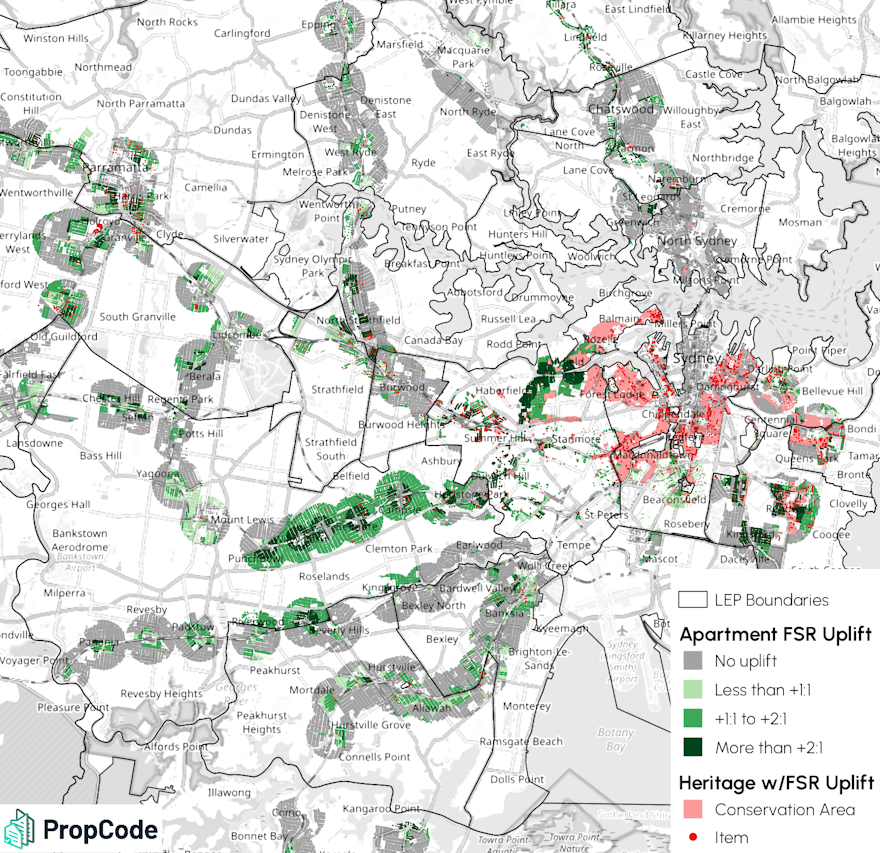A signature reform proposed in December 2023 in NSW, the “Low and Mid Rise Reform”, would increase housing density near rail stations and centres across NSW. These reforms have mostly remained unimplemented, and this article gives an update as at 3 January 2025.
PropCode can help you understand the planning rules that apply to your specific property: |
What was originally proposed for Low and Mid Rise Reform?
The reform only applies within the Six Cities Region (Sydney-Hunter-Shoalhaven), excluding regional NSW. The following proposed rules would override any local rules within 800m of stations and centres:
Mid rise housing (up to 6 storeys)
- Residential flat buildings permissible in R3 Medium Density Residential zone
- Height limit of 16-21m and floor space ratio of 2:1-3:1 for residential flat buildings and shop top housing
- No minimum site area or width
- Tweaks to the Apartment Design Guide to distinguish 6 storey buildings from taller ones
Low rise housing (up to 2 storeys)
- Any form of housing up to 2 storeys permissible in R2 Low Density Residential zone
- Subdivision of terraces permissible, with unspecified minimum lot area and width
- Floor space ratio of 0.7:1-0.8:1 for terraces, apartments, and villas
- Specified minimum lot area of 500-600 sqm and lot width of 12-18m
- 0.5-1 car parking spots per dwelling
Stations and centres definition
- any train, metro, or light rail station
- centres zoned E2 Commercial Centre or SP5 Metropolitan Centre
- centres zoned E1 Local Centre or MU1 Mixed Use, but only if enough shops and services were in the centre
What has NSW Government said since then?
According to the current DPHI webpage on the reforms, the NSW Government expects to implement most of the original proposal with these clarifications and changes:
- “Particular town centres and stations within Sydney, Central Coast, Illawarra, and the Hunter region will be identified in the SEPP, and town centres will be mapped. An 800 m walking distance from the town centre or station will be where the policy will apply.”
- “Maintain local character and the viability of employment centres by excluding the application of the reforms within the employment/town centres themselves (i.e. the E1, E2, MU1 and SP5 zones)”
- “All policy exclusions introduced in stage 1 will be maintained and apply to stage 2” - these exclusions as implemented in stage 1 on 1 July 2024 are:
- certain constrained or sensitive areas (heritage item, flood, bushfire, ANEF 20+, coastal sensitive, proximity to pipeline)
- several specific LGAs (Bathurst, Blue Mountains, Hawkesbury, Wollondilly)
- “Keep the Apartment Design Guide unchanged”
- “New landscaping provisions relating to tree canopy cover, the provision of deep soil areas and tree planting rates are proposed… It is intended that existing local controls in local environmental plans and development control plans, or in existing state policy such as the Apartment Design Guide, will prevail where a greater greening outcome would be delivered.”
What other refinements might be made?
In May 2024, a leaked Policy Refinement Paper contained other potential refinements that have not otherwise been publicly announced:
- Density controls would be reduced from the original proposal:
- 0-400m to station/centre would be limited to 6 storey and 2.2:1 FSR (reduced from 3:1 FSR)
- 400-800m to station/centre would be limited to 4 storey and 1.5:1 FSR (reduced from 2:1 FSR)
- R1 General Residential zones may only be eligible for new 4-6 storey density if their existing controls already allow more than 2 storeys
- Stations would qualify only with:
- in Greater Sydney - at least 4 trains/hour
- elsewhere in Six Cities Region - at least 2 trains/hour and near a town centre
- Centres would qualify only where they have a supermarket of at least 2,000 sqm and bus service at least 1/hour
DPHI performed further consultation with Councils during 2024 to refine the list of centres but has not publicly stated any outcomes.
What is the timeframe for implementation?
The NSW Government has continued to state they are committed to Low and Mid Rise Reform. However they have not given any precise timeframe to implement the full reform. The DPHI website still states “to be announced later in 2024” and “come into effect second half of 2024”, but these timeframes have obviously passed already.
The TOD SEPP reform has been mostly implemented already, except for a handful of stations where Councils are progressing their own master planning for similar density uplift.
It's unclear what or when the next step is for Low and Mid Rise Reform, but in the meantime you can use PropCode to check existing planning rules for your property and project - just click HERE.
![[object Object]](https://umsousercontent.com/lib_heZDZMqkJicLuLKJ/igzynodna381foma.png?w=358)
